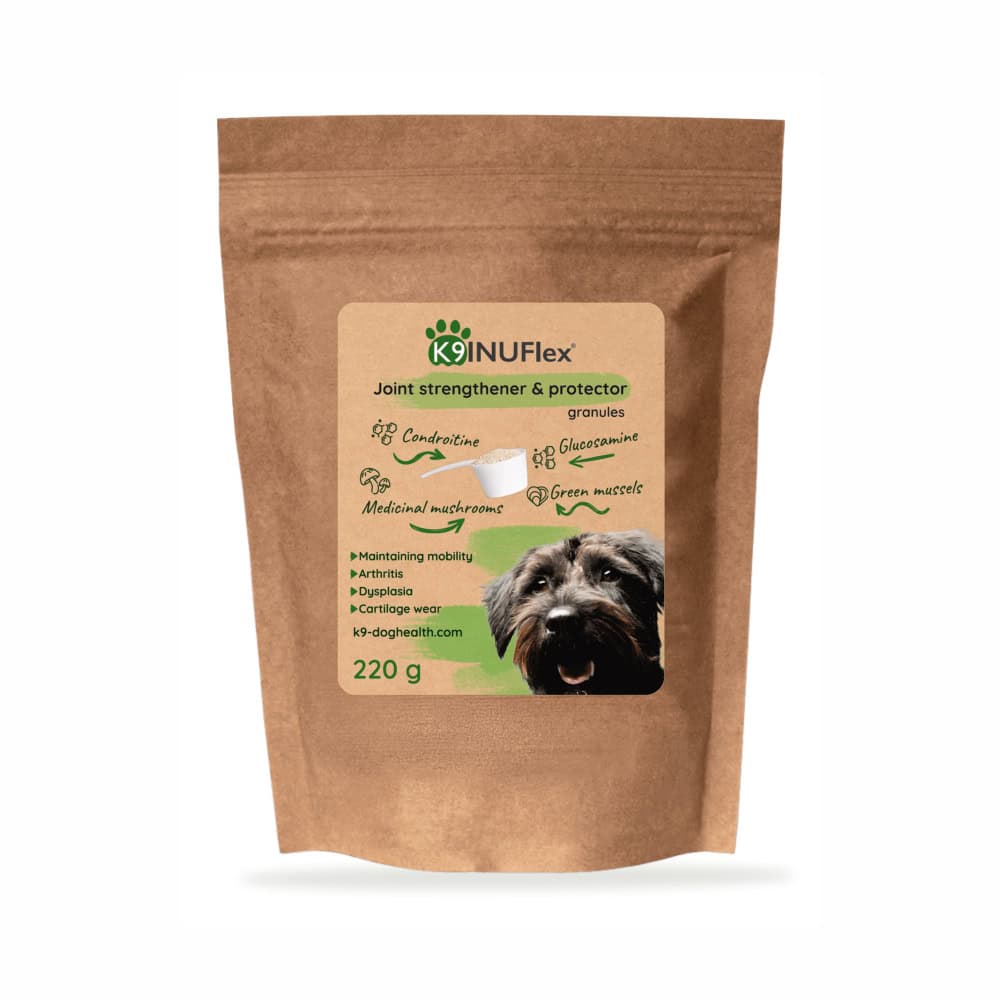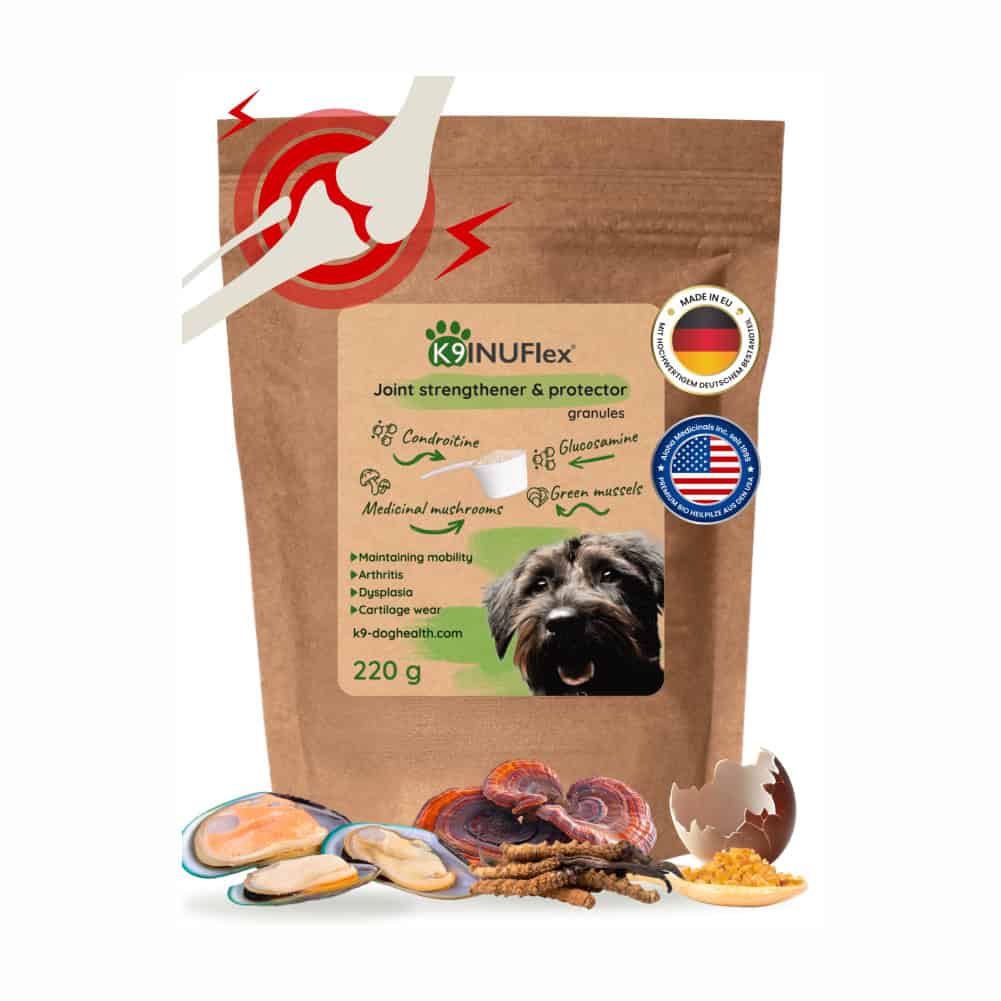Elbow dysplasia in dogs – Symptoms, treatment, and natural support
Elbow dysplasia in dogs is the second most common hereditary musculoskeletal disorder after hip dysplasia, and it mainly affects large breeds. Because the joint surfaces do not fit together properly, this mismatch gradually leads to cartilage wear, pain, and reduced mobility. Therefore, early recognition and proper treatment are essential to preserving your dog’s quality of life.
What is elbow dysplasia in dogs?
Elbow dysplasia occurs when the articular surfaces of the humerus and forearm bones do not fit together properly. As a result, this mismatch creates excessive pressure in some areas and instability in others. Over time, it may also lead to cartilage fragmentation (ununited anconeal process, fragmented coronoid process), osteochondrosis dissecans, and degenerative joint disease with cartilage wear and new bone formation (arthrosis).

Types of elbow dysplasia
Similar to hip and shoulder dysplasia, two main categories are recognized:
- Breeding perspective elbow dysplasia: dogs with abnormal joint structure confirmed by X-ray, but showing no clinical signs. They still carry and pass on the disease.
- Clinically dysplastic dogs: dogs with structural defects that show lameness, mobility problems, and pain requiring treatment.
Related articles on dysplasia
Dysplasia can appear in different joints in dogs. The most common form is hip dysplasia (HD), often simply referred to as “dysplasia.” Elbow dysplasia (ED) is becoming increasingly common, while shoulder dysplasia is less known but just as serious if left undetected.
Symptoms by age
- Puppyhood (5–9 months): recurring lameness, as well as pain after exercise, and swelling of the elbow joint.
- Adulthood: persistent mobility issues, and sometimes reluctance to play, together with stiffness.
- Senior dogs: lameness after rest, with reduced extension and flexion, and significant pain.
Diagnosis
Diagnosis of canine elbow dysplasia requires a full orthopedic exam. X-rays, CT scans, and arthroscopy help confirm the condition. Early detection is critical: surgery often brings good results in young dogs, while options are more limited in older animals.
Treatment options
- Conservative treatment: includes rest, anti-inflammatories, joint supplements, physiotherapy, and hydrotherapy. In many mild cases, these methods may already provide relief.
- Surgical options: such as arthroscopy, removal of cartilage fragments, and osteotomy. Therefore, surgery is usually recommended for severe or advanced cases.
- Rehabilitation: involves physiotherapy, swimming, and controlled exercise. Moreover, consistent rehabilitation helps maintain mobility and prevents further joint damage.
Natural support for canine elbow dysplasia
Alongside medical care, several natural substances may help protect the joints and reduce inflammation. In particular, the following options are well known for their benefits:
- Omega-3 fatty acids (EPA, DHA): reduce inflammation and improve mobility. Moreover, K9 INUKrill® is a premium source.
- Green-lipped mussel: a natural source of glucosamine and chondroitin, and it helps maintain cartilage structure.
- Eggshell membrane: in addition to being rich in collagen, elastin, and hyaluronic acid, it also strengthens connective tissues.
- Collagen peptides: support cartilage and connective tissue regeneration, and therefore aid in long-term joint health.
- Curcumin: a powerful antioxidant and natural anti-inflammatory that also protects against oxidative stress.
- Boswellia serrata: reduces pain and inflammation in joints; in addition, it may improve mobility in chronic cases.
- Hyaluronic acid: improves joint fluid viscosity, which in turn cushions and lubricates the joint.
- Vitamins C and E: provide antioxidant protection for cartilage, and they further support the immune system.
These supplements cannot cure the disease, but they may ease symptoms and slow down progression.
Nutrition and lifestyle
Proper nutrition, maintaining an ideal body weight, and choosing the right exercise (short walks, swimming) are vital. In addition, you should avoid jumping, stairs, and excessive strain. As a result, a joint-friendly diet combined with supplements can greatly improve your dog’s long-term quality of life.
Prevention of elbow dysplasia in dogs
Since elbow dysplasia is hereditary, responsible breeding and screening of the parents are crucial. Puppy screening, regular vet checks, and attentive owners can reduce the severity of the disease.
Prognosis
The outlook depends on severity, timing of diagnosis, and treatment. Consequently, milder cases allow dogs to live long, good-quality lives. However, severe and untreated cases can cause persistent pain and mobility issues even at a young age.
Frequently asked questions about elbow dysplasia in dogs
❓ Which breeds are most affected by elbow dysplasia?
Large breeds such as Labrador Retriever, Golden Retriever, German Shepherd, Bernese Mountain Dog, and Rottweiler are most commonly affected.
❓ Can elbow dysplasia be completely cured?
As it is hereditary, full recovery is not possible. However, surgery, medication, and natural supplements can manage symptoms and slow progression.
❓ Can it be managed without surgery?
In mild cases yes: weight control, physiotherapy, swimming, and joint supplements can help. In severe cases, surgery is usually necessary.
❓ What natural supplements can help?
Omega-3 fatty acids, green-lipped mussel, collagen peptides, curcumin, boswellia, and hyaluronic acid can support joint health. Moreover, they may also help reduce inflammation and improve overall mobility.
❓ What can I do at home for my dog?
Provide a comfortable, non-slip bed, and avoid stairs to reduce strain. In addition, keep your dog at a healthy weight, and give vet-recommended joint supplements for better support.
Summary
Elbow dysplasia in dogs is a serious hereditary joint disorder. When recognized early and managed with a combination of veterinary treatment, responsible breeding, proper nutrition, and natural support, dogs can enjoy a long and happy life.
For more on the role of diet, read our article on dysplasia and proper nutrition.
Note: This article is for informational purposes only. It is not a substitute for veterinary diagnosis or treatment. Therefore, always consult your veterinarian to ensure the correct diagnosis and appropriate therapy. In addition, because every dog is different, your vet can provide guidance that fits your pet’s individual needs.
References:
- Cook, C. R., & Cook, J. L. (2009). Diagnostic imaging of canine elbow dysplasia: a review. Veterinary Surgery, 38(2), 144–153.
- Lavrijsen, I. C. M., Heuven, H. C. M., Meij, B. P., Theyse, L. F. H., Nap, R. C., Leegwater, P. A. J., & Hazewinkel, H. A. W. (2014). Prevalence and co-occurrence of hip dysplasia and elbow dysplasia in Dutch pure-bred dogs. Preventive Veterinary Medicine, 114(2), 114–122.
- Kirberger, R. M., & Fourie, S. L. (1998). Elbow dysplasia in the dog: Pathophysiology, diagnosis and control. Journal of the South African Veterinary Association, 69(2), 43–54.
- LaFond, E., Breur, G. J., & Austin, C. C. (2002). Breed susceptibility for developmental orthopedic diseases in dogs. Journal of the American Animal Hospital Association, 38(5), 467–477.
- Sandell, L. J. (2012). Etiology of osteoarthritis: genetics and synovial joint development. Nature Reviews Rheumatology, 8(2), 77–89.
- Hazewinkel, H. A. W., & Nap, R. C. (2009). Elbow dysplasia in the dog. Educational review, EJCAP, 19(1), 63–70.




